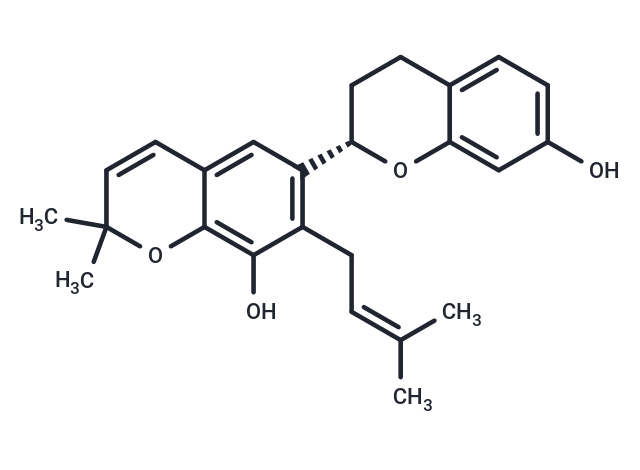Shopping Cart
- Remove All
 Your shopping cart is currently empty
Your shopping cart is currently empty

Kazinol B is an inhibitor of nitric oxide (NO) production, an isopentenylated flavan with a dimethylpyran ring.Kazinol B improves insulin sensitivity by activating the insulin-Akt signalling pathway and AMPK, which enhances glucose uptake.Kazinol B stimulates gene expression and secretion of adiponectin and can be used to study diabetes.

| Pack Size | Price | Availability | Quantity |
|---|---|---|---|
| 5 mg | $1,760 | Backorder |
| Description | Kazinol B is an inhibitor of nitric oxide (NO) production, an isopentenylated flavan with a dimethylpyran ring.Kazinol B improves insulin sensitivity by activating the insulin-Akt signalling pathway and AMPK, which enhances glucose uptake.Kazinol B stimulates gene expression and secretion of adiponectin and can be used to study diabetes. |
| In vitro | Kazinol B (2-20 μM ; 5 days) dose-dependently increases PPARγ and C/EBPα protein and mRNA levels in MDI-treated 3T3-L1 adipocytes.[1] Kazinol B (10-20 μM ; pre-treated for 1 h followed by 1 h insulin) dose-dependently increases insulin-dependent Akt phosphorylation.[1] Kazinol B (2, 10 and 20 μM ; 72 hours) shows no toxicity to adipocytes in 3T3-L1 cells.[1] Kazinol B (2-20 μM ; 72 hours) dose-dependently increases lipid accumulation by 2.4-fold (at 20 μM) treatment as compared with MDI-treated cells.[1] Kazinol B (2-20 μM ; 24 hours) increases the retained 2ʹNBDG-fluorescence in cells in a dose-dependent manner in differentiated 3T3-L1 adipocytes and C2C12 myoblasts.[1] Kazinol B dependently increases the MDI-stimulated GLUT4 mRNA level up to 4.7-fold as compared with MDI-only treated cells.[1] Kazinol B (6.25, 12.5, 25, 50 μM ; 18 hours) dose-dependently reduces amounts of iNOS protein in macrophages (RAW 264.7 cells) activated by LPS (1 ug/mL).[2] |
| Molecular Weight | 392.49 |
| Formula | C25H28O4 |
| Cas No. | 99624-27-8 |
| Smiles | C(C=C(C)C)C1=C(C=C2C(=C1O)OC(C)(C)C=C2)[C@H]3OC=4C(CC3)=CC=C(O)C4 |
| Relative Density. | no data available |
| Storage | store at low temperature,keep away from direct sunlight | Powder: -20°C for 3 years | In solvent: -80°C for 1 year | Shipping with blue ice. |
| Solubility Information | DMSO: Soluble |

Copyright © 2015-2025 TargetMol Chemicals Inc. All Rights Reserved.